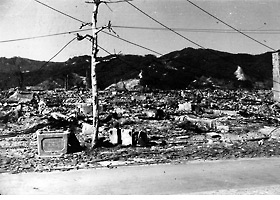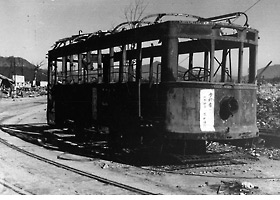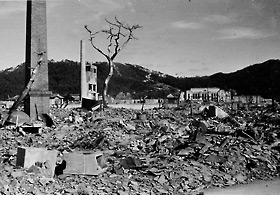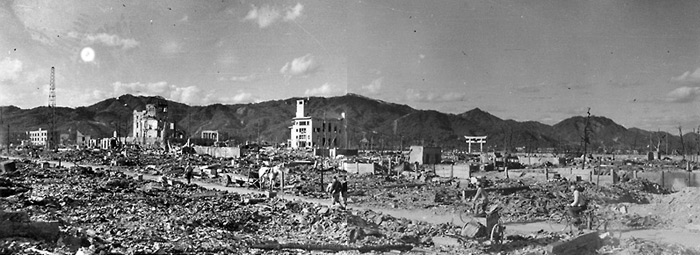My Unrecognizable Hometown
On August 18, 1945, Sasaki returned from Tokyo to his hometown, Hiroshima. Coming from the roofless platform of Hiroshima Station, he saw that the scorched ground stretched as far as the eye could see. He first headed toward Nishi-tokaichi-machi (his birthplace) only to find it destroyed without a trace. Nor could he find any of his family members.
Thinking that he could at least record evidence of his relatives having lived there, he pointed his camera at the former site of his birthplace. That was the starting point for his photographic activities in Hiroshima that continued for so long.
Losing Relatives
"There's no doubt about the death of my relatives. I subconsciously pointed my camera and pressed the shutter. The hollow sound of the shutter then still lingers in my ears." ("Hiroshima Since August 1945" by Yuichiro Sasaki, the Asahi Shimbun Company)
 |
Former site of home1945 |
|||
A streetcar exposed to the A-bomb near the Tokaichi stop1945
Sasaki found a message about his eldest brother's whereabouts written with charcoal on the scorched streetcar body, and visited the brother's evacuation location. The brother, who was at home in the air-raid shelter did not sustain any external injuries as a result of the A-bombing, but died at the evacuation site on August 30.
|
 |
|||
The City Disappeared
Sasaki's shooting area extended from the area of his home to the central part of Hiroshima City. The place where there once was a bustling town full of active people had been reduced to ashes. To record their traces, Sasaki went around the ruins day after day.
 |
Hirose Shrine1945
Hirose Shrine in the vicinity of Sasaki's home. The pavilions and trees in the precincts were all burned and turned to ashes. The stone-carved guardian dogs and garden lanterns are still present, having been left unburned by the A-bomb.
|
|||
Hiroshima Station1945
View of the burned-out ruins of Hiroshima JR Hospital and Hiroshima Station further away, from Kyobashi-cho to the north. Hiroshima JR Hospital collapsed and went up in flames, only leaving the chimney and walls of the boiler wing unburned. Hiroshima Station building was seriously damaged by the bomb blast and fire.
|
 |
|||
 Hypocenter area1945
View looking northwest from the hypocenter area. From the left, the photograph shows the iron tower of Hiroshima Post Office, Hiroshima Prefectural Industrial Promotion Hall (A-bomb Dome), Hiroshima Prefectural Commerce Association, and the great torii gate along the path to Hiroshima Gokoku Shrine. In the burnt ruins stretching forward was the area ranging from Saiku-machi to Sarugaku-cho.
|
